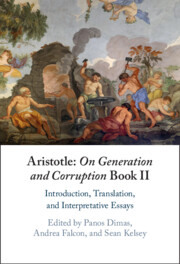 Aristotle: On Generation and Corruption Book II
Aristotle: On Generation and Corruption Book II from Part I - Introduction and Interpretative Essays
Published online by Cambridge University Press: 10 November 2022
GC II 7 supports Aristotle’s elemental theory, according to which the four elements possess a common matter that enables their inter-transformation, over the superficially similar Empedoclean one, by arguing that the former theory, and it alone, can accommodate the formation of homogenous stuffs like flesh and bone from the four elements. According to the interpretation offered here, these stuffs are mixtures in the sense spelled out in GC II 10, and appear to be exhibit the kind of strong uniformity that some interpreters have denied to Aristotelian mixtures. Special attention is devoted to bringing out the significance of elemental mixture for Aristotle’s twin projects in GC: understanding the causes of generation and destruction and establishing a theory of the elements. Explaining the formation of elemental mixtures is a crucial step in showing how the generation of more complex substances is possible and how the four elements, as he conceives them, function as elements of more complex substances.
To save this book to your Kindle, first ensure no-reply@cambridge.org is added to your Approved Personal Document E-mail List under your Personal Document Settings on the Manage Your Content and Devices page of your Amazon account. Then enter the ‘name’ part of your Kindle email address below. Find out more about saving to your Kindle.
Note you can select to save to either the @free.kindle.com or @kindle.com variations. ‘@free.kindle.com’ emails are free but can only be saved to your device when it is connected to wi-fi. ‘@kindle.com’ emails can be delivered even when you are not connected to wi-fi, but note that service fees apply.
Find out more about the Kindle Personal Document Service.
To save content items to your account, please confirm that you agree to abide by our usage policies. If this is the first time you use this feature, you will be asked to authorise Cambridge Core to connect with your account. Find out more about saving content to Dropbox.
To save content items to your account, please confirm that you agree to abide by our usage policies. If this is the first time you use this feature, you will be asked to authorise Cambridge Core to connect with your account. Find out more about saving content to Google Drive.